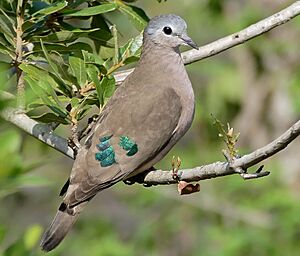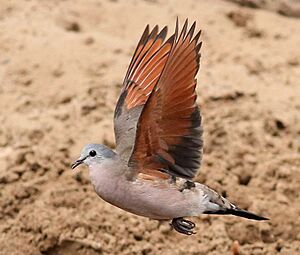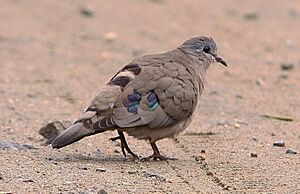Emerald-spotted wood dove facts for kids
Quick facts for kids Emerald-spotted wood dove |
|
|---|---|
 |
|
 |
|
| At Hluhluwe-Umfolozi and uMkhuze Game Reserves respectively | |
| Conservation status | |
| Scientific classification | |
| Genus: |
Turtur
|
| Species: |
chalcospilos
|
The emerald-spotted wood dove (also called the emerald-spotted dove) is a small, beautiful bird. Its scientific name is Turtur chalcospilos. You can find these doves living in eastern and southern Africa. They like to live in open forests and areas with new tree growth. They do not live in very wet rainforests or very dry deserts. They belong to the Columbidae family, which includes all doves and pigeons.
What Does It Look Like?
The emerald-spotted wood dove is a small, round bird. It is usually about 20 centimeters (8 inches) long. Its back, neck, wings, and tail are a light grey-brown color. The parts of its wings that fold have shiny green spots. These spots look like emeralds, which is how the bird got its name!
The lower back and tail have dark, blackish stripes. The top of its head is bluish-grey. This color fades to a pinkish-grey on its throat. Its belly is a pretty mauve-pink color, becoming whiter near its legs.
The dove's beak is black with a red base. Male and female doves look very similar. However, the female might be a little bit duller in color. Young doves have less bright green spots. They also have buff-colored edges on their feathers.
How to Tell Them Apart
When this dove flies, you can see its bright chestnut-colored underwings. This helps tell it apart from the black-billed wood dove. The black-billed wood dove has different colored underwings.
Their Call
The emerald-spotted wood dove has a special call. It has three parts. First, there are two soft, long cooing sounds. Then, it makes a series of slow coos that get lower in sound. This part lasts about 10 seconds. Finally, it finishes with 4 seconds of fast coos. These last coos get quieter and quieter.
How They Live
Emerald-spotted wood doves are not usually found in large groups. However, they might gather together at waterholes to drink. These doves usually look for food on the ground. They eat grass seeds and other small seeds.
Reproduction
The emerald-spotted wood dove builds a simple nest. It uses thin sticks to make the nest in a tree or bush. The female dove lays two cream-colored eggs. Both the male and female doves take turns sitting on the eggs. They incubate the eggs for about 13 to 17 days until they hatch.
After the baby doves (called squabs) hatch, both parents feed them. The squabs stay in the nest for another 13 to 17 days. Then, they are ready to leave the nest. Many young birds are sometimes caught by animals like mongooses and shrikes.



